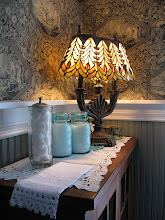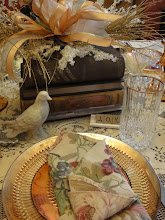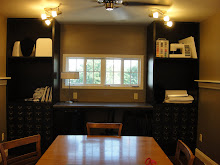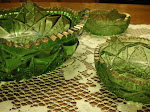I want to share with you how to make your own labels for your sewing projects . . .
I make and sell these lovely padded cell phone carriers that clip-on at the neckline, lapel, purse straps, or waistline. The carriers feature a lasso stitch beaded closure. This one is typical, decorated with couching, hand dyed yarns, shiny bits stitched in place.
The polymer clay beads I make by hand--about 50-60 pieces is an evening's work. Other evenings, I embroider wool medallions, adding a few glass beads. To make my purses and carriers--recycled wool and corduroy men's and ladies jackets, and the linings are cotton prints and batting leftovers from quilting projects. A great project for scrap busting.
Getting back to the reason for writing this post . . . to show you how tot stamp labels.
INKS
Purchased two tins of COLOR BOX permanent fabric inks in WICKED BLACK and in PUTTY.
The Putty color ink is more transparent, and didn't show up on any fabrics! However, it did produce a stamp image on the white price tag example.
I returned the Putty ink for refund, and purchased a WHITE permanent fabric ink by VersaCraft.
***
The stamp was created for me by Ashley from her Etsy Shop SayaBellStamps. The stamp size, the fonts--it is PERFECT. Great customer service--likes working with her clients. Wonderful!
Experiment #1
Working with Contrast and Fabric Texture
1. White VersaCraft ink on the Black Linen Upholstery fabric doesn't make a good stamp transfer.
The problem is the Black Linen Upholstery fabric has too much texture (too bumpy, not flat enough to make a good imprint).
Stamping the back, (lighter side) (smooth side) of the Linen fabric with WICKED BLACK ink by COLOR BOX works well.
I use a sewing machine to sew-in upholstery fabric stamped labels to purse or soft luggage linings during construction.
While a perfectly wonderful label making material--some upholstery fabrics even though they have a nice stabilizer backing on them can have a tiny bit of hairyness, or fraying along their rotary cut edges.
BUT--this can be eliminated with a finger dampened with Fray-Check around the perimeter. It takes only seconds to do.
The Olive Green Upholstery micro suede fabric has a smoother surface than the black linen. Here, I've stamped with the white ink, and again with the black ink.
One more important thing about these fabric inks . . . they take some time to dry--otherwise the ink will smear.
Allow several hours drying time. Clipped the stamped strips to the window curtain in my studio, a safe place for them to dry.
2. The Stamping Fixture
I asked my husband Jon to build a fixture for stamping. He selected a 36" board, and screwed two metal yard sticks to the board. My drawing and instructions asked for a WOOD YARD STICK, cut in half, glued to a 24" long board. Ok. well, so much for the drawing and instructions . . .
There is an advantage to using the WOOD YARD STICK. Because it is a thicker material, it provides a deeper channel to hold the 1 inch rotary cut strip of fabric. And if your fabric strip wants to curl a bit, you can use a dab of stick glue here and there along the length of the channel to keep the fabric in place.
3. Another Approach
Since textured fabric has issues, I decided to try some dark blue cotton fabric with the white opaque fabric ink. Very pleased with the results. Here's what I did . . .
Cut the blue cotton strip of fabric wider (1-1/2 inches wide), and this time I didn't use the stamping board fixture.
Lay the 1-1/2" wide fabric strip horizontally on an old cutting mat, and go ahead and dab with some stick glue if you want. Used the old cutting mat grid, stamping as straight as possible, producing about 10 labels and hung the strip up to dry for half a day--while I worked on a quilt.
Separated the 10 dried labels cutting them using the rotary cutting mat grid. Then, took the labels to the ironing board and carefully turned the edges under and pressed. Threaded my needle with matching blue thread and pinned a label to the cell phone carrier, stitching it with tiny applique stitches (about two minutes work--not a problem).
I like the stamp imprint and the soft cotton fabric and how easy it was to stitch in place. This is a winner.
I hope you'll try this. It is fast and fun. You deserve something fast, fun, and economical.
Consider this--every stamped label I save 40 cents. That is the price I used to pay to have an online supplier make 120 labels for me ($60.00) plus shipping.
After years of buying printed labels from this same online supplier--most of the time waiting as much as six weeks for my label orders, I sent her many emails begging her to get off her butt and send me my label order, and she would ignore my pleading. Finally, I decided--THIS STINKS. I'VE HAD ENOUGH. I'LL MAKE MY OWN LABELS.


























.jpg)
















Hello Linda, You always take such exquisite care with every detail. I just looked up Scandinavia, Wisconsin. Apparently the population is only 363 (quite a difference from Taipei), but the quality of your work is really putting it on the map!
ReplyDelete--Jim